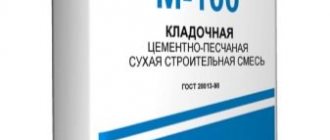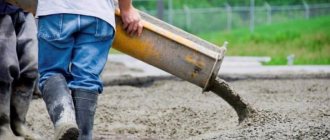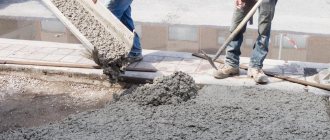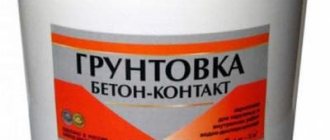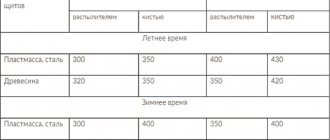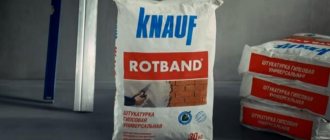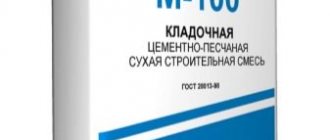Sand concrete M200 is a dry construction mixture of excellent quality, which is produced in accordance with the norms and standards clearly stated in GOST 28013-98. The mixture is universal and is used in a variety of areas: manufacturing various parts and structures, performing preparatory work, and other repair and construction tasks.
Sand concrete M200 contains Portland cement, sand, crushed stone and various additives to improve and correct properties. All of the listed components give the mixture the necessary plasticity, a certain strength, sufficient water resistance, high resistance to frost, rust, and external negative factors.
Sand concrete M 200 is sold in convenient containers of 40/50 kilograms, so there is no need to independently calculate proportions and select components. It is enough to purchase the required volume of the mixture, fill it with water according to the instructions on the bag and work with the material.
The main advantage of this brand of sand concrete is the ability to carry out finishing, repair/construction, and installation work at air temperatures ranging from +5 to +350 degrees. Provided that special additives are added to the composition for resistance to frost, the mixture becomes suitable for operation at temperatures down to -15C.
Where is it used?
Sand concrete M200 has a good composition, so the mixture is used quite widely - in various fields to implement many tasks. The solution demonstrates a high drying rate and minimal shrinkage, therefore it is most relevant in low-rise construction of industrial/domestic premises, in finishing and installation work.
Where is sand concrete M200 used:
- Concreting of various structures that are not expected to be exposed to too heavy loads
- Masonry of different types of blocks and bricks
- Sealing gouges and cracks
- Pouring the foundation
- Work on leveling floors, walls, ceilings, grouting joints between blocks
- Preparation and filling of floor screeds (especially important for heated floors)
- Filling walls and other vertical structures
- Landscaping of the local area - filling of pedestrian paths, garden paths
- Restoration of various surfaces
The mortar (sand concrete M200) can be laid in a thin or thick layer on horizontal/vertical surfaces. Thanks to the composition of the mixture, it is possible to significantly improve the technical characteristics of buildings and guarantee the reliability and durability of structures.
Dry masonry mixture M200 is ideal for:
- Carrying out civil works;
- Concreting floors, stairs, retaining walls, paths, structural parts;
- Screed devices for heated floors;
- Leveling the surface of walls, floors, ceilings;
- Sealing joints between slabs and blocks;
- Finishing of external surfaces that will not require additional waterproofing;
- Anchoring of metal elements, as a fastening element when installing reinforced concrete structures;
- Masonry made of bricks and blocks of various sizes (as masonry mortar), etc.
Compound
Sand concrete M200 contains several components in certain proportions - all of this is regulated by GOST 31357-2007. Manufacturers are allowed to make minor adjustments to the composition of the dry mixture to improve properties and achieve the desired characteristics, but the main components and their volumes (as well as the exact parameters) must remain unchanged.
Components included in sand concrete M200:
- Portland cement grade M400
- River sand of fine and coarse fractions - always thoroughly cleaned of impurities beforehand
- Fine crushed stone
- Water
- Additional dry mixtures – plasticizers, additives, special substances
Consumption of M200 sand concrete per cubic meter:
- 265 kilograms of Portland cement - 1 part
- 860 kilograms of sand – 2 parts
- 1050 kilograms of crushed stone – 5 parts
- Approximately 180 liters of water - volume may vary
Factors influencing the consumption of cement mixture
The weight and volumetric inclusion of cement powder in the prepared consistency is greatly influenced by what types of binder are used. Along with their use, the properties and parameters that a high-quality concrete structure has are important. The following factors are of great importance for the conditions for the use of consistency components:
- Volumetric inclusion of components (sand scattering, crushed stone). The binder is poured in an increased volume if the presence of solid aggregates increases, because they need to be fastened. It is for this reason that consistency components are usually calculated based on volumetric and weight values for cement powder.
- The grade of cement - along with its increase, the strength of the created structures increases. As for the brand identity of the manufactured consistency, it is 1.5-2 times lower due to the presence of additional components.
- Required grade of concrete consistency. Only by knowing it can you accurately calculate the amount of cement powder and fillers per cubic meter of prepared building material. The main brand ratios were indicated earlier in tabular format.
- Density of cement powder. The average value is 1300 kg/cubic meter, but it changes over the course of a year or other storage period. This value is also affected by transportation and various environmental factors.
As you can see, the too high importance of all kinds of factors makes the use of cement powders much more difficult. If the information presented in this article is not enough, then detailed video instructions will certainly help you.
Advantages and disadvantages
Sand concrete M200 is a universal mixture, widely used in a variety of fields: from brickwork and underfloor heating screed to pouring walkways and restoration.
The main advantages of the mixture:
- Relatively low price of material
- Simplicity and ease of self-preparation - just buy a big bag, read the instructions, add the required amount of water, mix and use
- Environmentally friendly and safe for human health, thanks to which M200 sand concrete can be used for any task, including interior decoration and floor screeding in residential premises
- High drying speed - the solution can be used even for urgent concreting
- Preservation of the original appearance for a long time - sand concrete is not subject to the spread of cracks or deformations
- Sufficiently high compressive resistance values according to calculations
- Good level of frost resistance - even higher than that of many higher classes of concrete (subject to the introduction of special additives into the composition)
- Low thermal conductivity
- Significant improvement in sound insulation performance
- Preservation of properties during sudden temperature changes
Among the disadvantages of the material, only a few can be identified: fairly large packaging (minimum weight is 25 kilograms), water permeability (if special additives are not introduced), the importance of strictly observing the volume of water when preparing the solution (maximum 20% of the total weight of the solution).
Working with sand concrete M200 does not require special knowledge and skills; it is quite possible to cope with all stages on your own. The container always contains instructions with exact volumes and a description of the preparatory and main work.
To improve technical characteristics, special additives are used - they increase plasticity, frost resistance, resistance to the proliferation of microorganisms (mold and mildew), and corrosion. In addition, it is possible to add pigments that color the solution in one color or another and give it the desired shade.
Scope of application M200
The brand is widely used for:
- processing of vertical and horizontal seams (sealing cracks, chips);
- flooding paths paved with paving slabs;
- laying foundations (light options);
- flooding the floor.
The brand is considered the most suitable for plastering and masonry work.
Cement brand
The proportions of ready-made concrete, the basis of which is cement of this brand, are 1: 2.7: 4.7. For 1 kg of dry mixture there are 2.7 kg of river sand and 4.7 kg of crushed gravel (crushed stone can be used). The volume of finished concrete is 10-11 liters.
The original brand of cement is confirmed not only by certificates, but also by the reputation of the manufacturer. Before purchasing, you should read reviews about a particular product in advance. Unscrupulous dealers package sand concrete in original packaging, passing off low-strength material as high-quality products.
Components of cement mortar M200
The artificial mixture forms a dense structure only when the main components are mixed.
These include:
- Plasticizers. Impurities that allow you to slightly change the structure, consistency and chemical properties of the solution.
- Cement. A highly adhesive component that is compatible with most components in the concrete mortar.
- Liquid. Provides high-quality adhesion of cement and sand. The amount of water directly depends on the purpose of the solution.
- Sand. One of the main elements that ensures the strength of the coating. Quarry or river sand is considered the most suitable. The second type is suitable for monolithic structures.
The grade of cement is used in the construction of buildings for which heavy loads are not provided. If large-scale construction is planned (with a limited budget), fillers are added to the solution to help strengthen the foundation or seams.
Most popular supplements:
- Detergents. The products provide higher plasticity of the mixture. They can be added to the solution after water.
- PVA. Glue increases adhesive properties. It is added in small portions.
- Slaked lime. Increases the strength of the solution. The mixture containing this component is used for plastering walls.
You can also add graphite or carbon black: the components do not affect the chemical properties of the mixture in any way, but with their help you can slightly change its color.
Safety regulations
Experts recommend not to neglect safety rules. Dust is considered one of the hazardous production factors. Cement particles are small, have minimal weight, and are therefore easily transported by the wind. When working with dry mixtures, you must first put on a respirator and protective overalls.
Anti-dust masks need to be selected in size so that microparticles do not penetrate into the oral and nasal cavities. In addition to a respirator and a special suit, the builder’s arsenal must include safety glasses and gloves. Earplugs will help increase comfort and safety.
The liquid solution can corrode the skin. Ulcers take a long time to heal, and the risk of infection (foreign particles entering the deep layers of the skin) is high. If a person regularly comes into contact with a cement mixture or a solution based on it, a medical first aid kit with the necessary medications should be equipped within walking distance. People responsible for safety must check compliance with safety standards on a daily basis.
Peculiarities
Sand concrete is often referred to as an intermediate element between cement and concrete mixture. Dry material is often used for restoration, repair and construction work. It is lightweight and easy to work with, does not shrink, and has proven itself well on unstable soils. Sand concrete M200 is indispensable in the construction of concrete floors where serious loads are noted - garages, warehouses, shopping centers.
The mixture contains crushed stone and chemical additives, which ensures that the material does not shrink even with a fairly thick layer. Strength can be increased by using plasticizers, as well as ensuring sufficiently high frost resistance.
When adding various additives (especially to impart workability to the mixture), it is necessary to correctly determine the optimal volume in order to ensure the desired consistency without compromising the strength characteristics.
Pigments give sand concrete the desired color - there is also quite a wide variety here. The main thing is to choose the right supplement and work according to the instructions.
Installation recommendations
If laying is carried out using a concrete pump, the drop height of the mixture should not exceed 1 meter. If it is exceeded, there is a high probability of concrete delamination.
If construction work is carried out in the summer, it is necessary to protect the concrete mixture from dehydration. To do this, it must be watered or covered with film.
When laying a thick layer, you need to compact the concrete to remove air voids from it. Otherwise, the strength properties of concrete may decrease.
Specifications
All operating parameters that apply to M 200 concrete and mixtures are regulated by GOST 7473; they must be taken into account when performing calculations and design. The compressive strength of M200 sand concrete should be at least 200 kg/cm2. The remaining parameters are presented as averages, as they can vary depending on the type and volume of additives.
Main indicators of the mixture:
- Strength class – B15
- Frost resistance level – up to 150 cycles
- Water permeability – within W6
- Bending strength – 6.8 MPa
- The “life” of the finished solution is a maximum of 110 minutes (during this time the mixture must be used, as the solution will then lose its properties)
- The consumption of sand concrete is largely determined by the evenness of the base and the fraction of filler grains: the maximum is 1.9 kg/m2 per layer thickness of 1 millimeter
On average, one bag weighing 50 kilograms is enough to fill 2-2.3 square meters of thin screed. If the base for heated floors is being prepared, the consumption increases by one and a half to two times.
How to prepare TsPS?
Each ready-made mixture must be accompanied by instructions on the required amount of water; other components are usually not provided. When used as part of additional materials (dyes, reinforcing fibers), the proportions must be observed strictly in accordance with the instructions for the additive. The typical ratio of mixture to water is 5 to 1 (a bucket of water per 50 kg bag of mixture), the share of dyes is 0.1%, the share of fiber fiber is 1%.
When making it yourself, the proportions of water and sand to cement are taken depending on the type of work being carried out, strength requirements, and the degree of moisture content of the sand:
1. The thickest mortar required for masonry is the water/cement ratio of no more than 0.8.
2. For screed and plaster, sour cream-like compositions with a W/C ratio of 0.8–1.2 are used.
3. When spraying and grouting, dilute the solution even more, up to W/C - 1.5.
4. Mixtures with W/C less than 0.6 are used when it is necessary to obtain a quick-drying high-grade cement-sand mortar (M300 and higher), or for concrete.
If a concrete mixer is used for mixing, it is recommended to carry out the work in the following order:
- Pour water into the untwisted drum and add additives.
- Add 2 buckets of sand.
- Add a bucket of cement and wait for it to mix.
- Add the remaining sand and add water if necessary.
When kneading by hand, water is poured into the dry mixture. If you do the opposite, water forms a film of cement on the surface of small lumps of the mixture, which will slow down the process many times over. If the composition is made from its own components, it is advisable to mix them dry before adding water.
Once prepared, the solution must be used before it begins to harden - from 15 minutes to several hours, depending on the use of additives, cement concentration and temperature. The usual solution M150-M200 at a temperature of 20 ° C begins to harden an hour after mixing.
Consumption
To plan the mass of the CPS in advance, you need to approximately calculate the required volume of solution and multiply it by the cost per 1 m3 indicated in the description of the mixture. Most often they are indicated in the format “mixture consumption per m2”, meaning a layer 1 cm thick. To get the costs per 1 m3, just multiply the indicated value by 100.
The usual consumption values for sand-cement mixture are 1800 kg/m3, for high-quality compositions - up to 2200 kg/m3, for lightweight plasters with lime - 1200-1600 kg/m3.
Calculating the volume of consumption of mortar for plastering work and screed is not particularly difficult, but the cost of material for masonry depends on the skill of the particular performer. If you strictly follow the technology, the solution consumption will be 25% of the total volume of the wall, but in practice this value can be either up to 35% (thick seams, losses due to splashes) or below 20% (waste masonry, use of poor-quality techniques to speed up work ).
Preparation of the solution
Sand concrete M200 is a ready-made dry construction mixture that can simply be mixed with water, mixed thoroughly and used for 110 minutes. Despite the apparent simplicity of the task, it is necessary to carefully follow the stages of the work and strictly follow the instructions.
How to prepare a sand concrete mixture:
- The dry powder is poured into a container specially prepared for this - it must be dry and clean, of a suitable size.
- Pour in the required volume of water, stirring carefully and thoroughly - it is better to take water at room temperature (at least slightly cool)
- Stir until the solution reaches a homogeneous consistency and the lumps completely disappear from the structure - for this you can take a drill with a special attachment or a construction mixer
- Let the solution sit for 10 minutes
- Mix thoroughly again and use the mixture in your work.
It is important to follow the instructions: exceeding the specified volume of water will reduce the strength of the solution and may cause cracks to quickly spread. Provided that everything is done correctly, the coating can easily withstand a load of up to 200 kilograms per cm2.
The solution retains all its properties for 110 minutes, then the mass becomes unusable.
Safety Compliance
During the work process, sand concrete is applied to a clean, dry surface. Various cracks and potholes are covered in advance with the same mixture, and all weak areas are removed. If there are grease stains, they also need to be thoroughly cleaned. Pre-prepared walls are additionally treated with special strengthening impregnations to improve the quality of the finish.
During the work process, it is important to follow the rules and apply the mixture in an optimal layer: for leveling with reinforcement, the thickness of the layer is 4-10 centimeters, leveling without reinforcement - 2-5 centimeters, brickwork - up to 1.2 centimeters.
During work and during the first 3 days, it is necessary to exclude the possibility of drafts and direct ultraviolet rays. The solution sets within 2 hours, dries completely and reaches the specified characteristics within 28 days (if additives are included in the composition, much faster).
During the work, it is imperative to observe safety measures: use construction glasses (do not allow the mixture to get into your eyes), gloves, etc.
It is best to carry out work when the ambient temperature has reached at least +5 degrees. If special frost-resistant components are added to the composition, you can put the solution in frost. When using sand concrete, it is advisable to stir it periodically to avoid premature hardening in the container.
Consumption of cement and sand per cubic meter
There are established values for the consumption of mortar grades starting from M100 (usually the lowest grade is used only when sealing slab joints for subsequent plastering or cladding). So, for example, when carrying out masonry, during which ordinary bricks are used (or construction is carried out using other blocks), the following data is relevant:
| Brand name of cement powder | Brand of solution | Weight value, kg |
| M400 | M150 | 400 |
| M200 | 490 | |
| M500 | M150 | 330 |
| M200 | 410 |
However, when creating a concrete mixture for the foundation, one should not forget about the presence of other components in its composition, in particular, sand fractions and crushed stone (or gravel). Let's consider what share of the total value each of them makes up (in the tables).
For M400 cement, the following ratio of the components of the consistency is relevant:
| Brand identity of concrete consistency | Inclusion of constituent elements C:P:Shch, kg | Volumetric inclusion per 10 liters of cement batch P:Shch, l | Quantitative value of concrete consistency per 10 liters of cement batch, l |
| 100 | 1:4,6:7,0 | 41:61 | 78 |
| 150 | 1:3,5:5,7 | 32:50 | 64 |
| 200 | 1:2,8:4,8 | 25:42 | 54 |
| 250 | 1:2,1:3,9 | 19:34 | 43 |
| 300 | 1:1,9:3,7 | 17:32 | 41 |
| 400 | 1:1,2:2,7 | 11:24 | 31 |
| 450 | 1:1,1:2,5 | 10:22 | 29 |
Similar information is presented for cement M500:
| Brand identity of concrete consistency | Inclusion of constituent elements C:P:Shch, kg | Volumetric inclusion per 10 liters of cement batch P:Shch, l | Quantitative value of concrete consistency per 10 liters of cement batch, l |
| 100 | 1:5,8:8,1 | 53:71 | 90 |
| 150 | 1:4,5:6,6 | 40:58 | 73 |
| 200 | 1:3,5:5,6 | 32:49 | 62 |
| 250 | 1:2,6:4,5 | 24:39 | 50 |
| 300 | 1:2,4:4,3 | 22:37 | 47 |
| 400 | 1:1,6:3,2 | 14:28 | 36 |
| 450 | 1:1,4:2,9 | 12:25 | 32 |
Thus, you can prepare the consistency using a regular 10-liter bucket, if, of course, the volume allows for manual transportation of all the material.
It is believed that all calculations can be made based on the weight value of the cube of kneaded consistency. But that's not true! Sand is a fairly large element, and therefore finely ground cement powder, the structure of which is quite homogeneous, fills the voids between the remaining particles. Accordingly, after adding 200-400 kilograms, you can still get the same volume of consistency.
Water, by default, should be 50% of the weight value of the binder. It is added in portions to track when the resulting structural substance is thick enough. It is imperative to take into account the moisture content of the sand grains, because... this may require reducing the volume of fluid.
Visually, the concrete consistency is brought to an optimal state for various procedures. This is considered to be a state in which the building material is comfortably laid, it is easy to fill and level, and also when it is well held in the joint gaps and formwork. The required paste-like plasticity is achieved by regularly mixing the combined elements of consistency.
Storage
Sand concrete M200 is supplied in multilayer paper bags in a standard weight of 40/50 kilograms. If stored in a dry, closed place, the shelf life is 6-12 months (depending on what the manufacturer indicated). But cement tends to cake and pick up moisture from the environment, which significantly worsens its performance characteristics.
Therefore, it is best to purchase the mixture immediately before preparation and pay attention to the production time. In Moscow and the regions, many manufacturers sell the product, so purchasing sand concrete at the right time will not be a problem.
Properly produced in a factory and prepared on site, sand concrete is a universal mixture that can ensure the quality and durability of a variety of structures, monoliths, buildings, etc.


